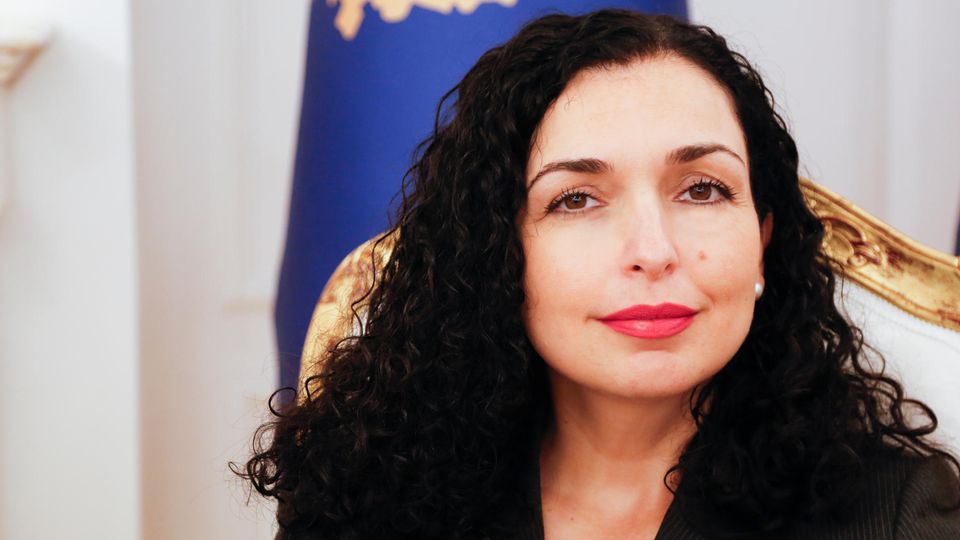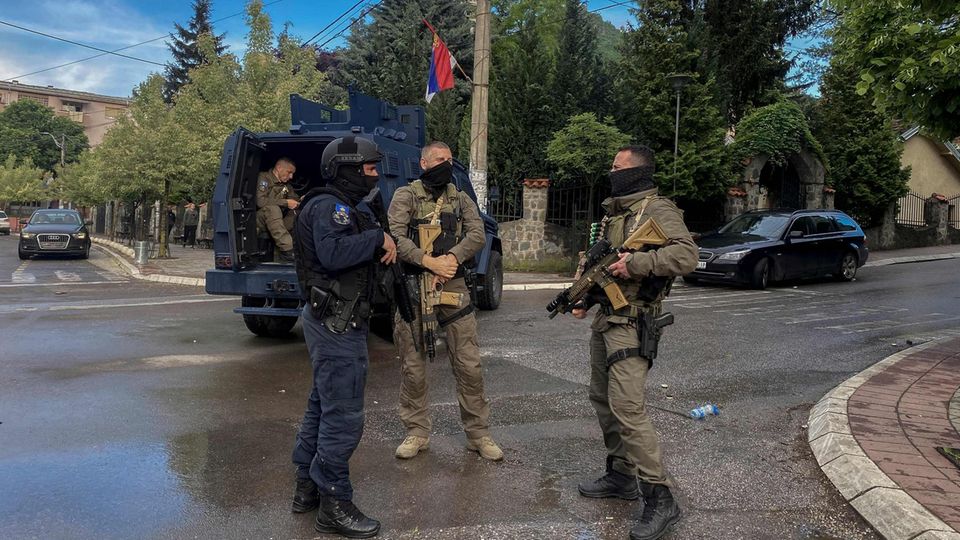The north of Kosovo on the border with Serbia is a troubled region. After riots there, NATO is now strengthening its Kfor protection force in Kosovo. That is what the dispute between the neighbors in the Western Balkans is about.
In the border area between Kosovo and Serbia, tensions between the neighbors have been manifesting themselves for years. The situation came to a head again earlier this week when militant Serbs attempted to storm the municipality of Zvecan in northern Kosovo. Soldiers from the international protection force KFOR and the Kosovan police confronted them and were attacked with stones, bottles and incendiary devices. According to Kfor, 19 Hungarian and 11 Italian soldiers suffered injuries in the clashes, including broken bones and burns. According to the hospital in the nearby town of Mitrovica, 53 Serbs were injured. Hundreds of Serbian demonstrators gathered again on Tuesday in front of the city administration. KFOR soldiers put up a metal barrier and prevented them from entering the building.
In view of the violent protests, NATO is now strengthening its protection force in Kosovo. The stationing of additional soldiers is a precautionary measure “to ensure that KFOR has the capabilities it needs to maintain security in accordance with our UN Security Council mandate,” said NATO commander Stuart B. Munsch on Tuesday at the alliance’s main operational command in Italy. He also called for an end to the violence.
What triggered the current clashes?
The cause of the most recent escalation are the local elections held by the Kosovan authorities in April in four Serb-majority towns. The Serbs had largely boycotted the elections, so the Albanian minority took control of the municipal councils despite an overall turnout of less than 3.5 percent. Now the Serbs are protesting against the new mayors taking office who come from the Albanian ethnic group. Their Serbian predecessors resigned from their posts last November in protest against the government in Pristina, which wanted the Serbs in the north to put Kosovar license plates on their vehicles instead of Serbian ones.
Kosovo, a country of 1.8 million people with a majority ethnic Albanian population, declared its independence from Serbia in 2008, but Belgrade still regards it as a Serbian province to this day. Around 120,000 Serbs live in Kosovo, mostly in the north. Albanians live almost exclusively in the rest of the country.
The Federal Foreign Office has long been warning of a tense situation in the border area. “Travelling to the north of Kosovo (Zubin Potok, Leposavic, Zvecan and North Mitrovica municipalities) is not recommended”, it says on the agency’s website. “It cannot be ruled out that there will be further security-related incidents that also affect foreigners or restrict general freedom of movement”.
Where does the conflict between Kosovo and Serbia come from?
The conflict between Kosovo and Serbia is deeply rooted in the neighbors’ past. In the Middle Ages, the Kosovo region was the seat of the religious and political center of Serbia. As the Ottoman Empire continued to expand into Europe and occupied the area in 1389, the Christian Serb population began to migrate and Muslim Albanians followed. Eventually, in the 20th century, the Albanians became the largest population group and the Serbs an ethnic minority.
Exhibition “Facing the Balkans”
So close and yet so foreign: photo reporter Harald Schmitt explores the Balkans
Against the will of the Albanian majority, after World War I in 1918, Kosovo became part of the newly formed Kingdom of Yugoslavia, which also included the constituent republic of Serbia. In 1974 the area was declared an autonomous province of Serbia. Fifteen years later, then-Serbian President Slobodan Milosevic revoked Kosovo’s autonomy and sent troops to quell protests.
The dispute over the status of Kosovo finally led to the 1998-1999 war between the Yugoslav army and Serbian paramilitary forces on the one hand and the Kosovo Liberation Army (UCK) and, from 1999, NATO forces led by the USA on the other . During the war, the Kosovar and above all the Kosovar-Albanian civilian population fell victim to systematic raids, expulsions and mass murders. The KLA was also guilty of serious human rights crimes. The war finally ended with Serbia’s withdrawal from Kosovo. The province was placed under UN administration and NATO stationed the KFOR protection force there, which also includes the Bundeswehr. Around 200,000 Serb residents and non-Albanians fled Kosovo’s attacks.
In 2005, Kosovo’s interim parliament, set up by the United Nations, voted to establish an independent state. The UN then launched a mediation mission on the future status of the Serbian province, which was declared a failure two years later. As a result, Kosovo unilaterally declared its independence on February 17, 2008. To this day, however, Serbia has not recognized this sovereignty and claims Kosovar territory as a central element of religious and national consciousness.
How does the rest of the world feel about Kosovo?
More than 110 countries consider Kosovo’s secession from Serbia to be legitimate and have recognized the Republic of Kosovo – including Germany and the USA. Russia and China, which for domestic reasons reject the right of peoples to self-determination enshrined in the UN Charter, see Kosovo’s independence as a violation of Serbian sovereignty in violation of international law.
Within the European Union, the attitude towards Kosovo is inconsistent: In addition to Germany, 21 other EU countries recognize Kosovo as independent. However, Spain, Greece, Cyprus, Slovakia and Romania do not. The background here is also the autonomy efforts of minorities in these countries, such as the Catalans in Spain.
What’s next for Kosovo and Serbia?
Talks on normalizing relations between Kosovo and Serbia have been taking place since 2011, mediated by the European Union. Serbia is a candidate for EU membership and Kosovo is considered a potential candidate country, and the EU has linked the accession prospects for the countries to reforms and substantial progress in overcoming interstate and internal conflicts. “But as long as influential EU states like France block the admission of new members, there is a real danger that the willingness to reform in Kosovo and the other states in the region will flag,” writes the Federal Agency for Civic Education. That is why Kosovo is the western Balkan country which is still the furthest away from possible EU accession.
However, the indefinite postponement of EU membership not only reduces the willingness of Pristina and Belgrade to implement the agreed reforms and continue their dialogue under EU mediation, it also opens the door to other powers such as China, Turkey and the Gulf States , so the BpB. Russia is also trying to reactivate its traditionally strong presence.
The conflict between the neighbors is also increasing resentment among the population and deepening the divisions, writes the Bundeszentrale: Kosovo Albanians, who make up around 87 percent of the population, and around eight percent of the Kosovo Serbs live largely separately in their own neighborhoods and villages . Serbs, but especially the smaller minorities — Montenegrins, Turks, Bosniaks, Roma, Goranci, Ashkaelia and Jews — suffered discrimination in areas such as land and property purchases, education, and job-seeking.
Sources: Ministry of Foreign Affair, Federal Agency for Civic Education, State Center for Political Education Baden-Württemberg, European ParliamentAFP, DPA




